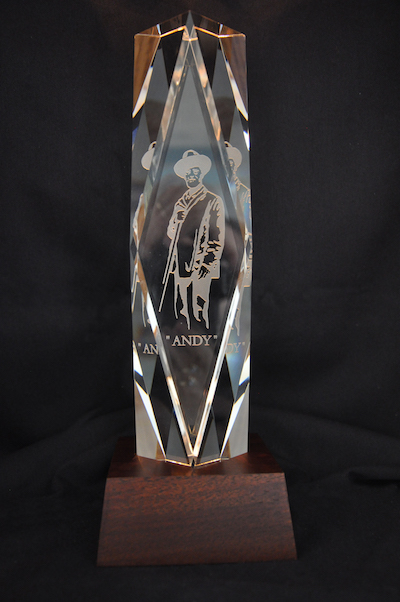|
MOA Annual Scientific Research Exhibit (SRE) Competition
The Michigan Osteopathic Association (MOA) hosts an annual Spring Scientific Research Exhibit (SRE) Competition during the state's largest osteopathic conference held May 15-18, 2025. The competition provides osteopathic medical students, residents, fellows and attending level physicians an opportunity to present their medical and scientific research to the medical profession.
Thank you, 2025 SRE Judges!
VIEW 2025 POSTERS (PDFs) & WINNERS HERE2025 SPRING SRE AWARDS Andrew “ANDY” Taylor Still, D.O. Award - $1500 & ANDY crystal trophy The Andrew "ANDY" Taylor Still, D.O. Achievement Award Andrew "ANDY" Taylor Still, D.O. Achievement Award may be presented to an outstanding exhibit that reflects the principles of osteopathic medicine in research during the MOA spring conference. The ANDY Award, which includes an exquisitely carved crystal piece and a $1500 cash prize, is not awarded every year.
ANDY AWARD WINNERS 1993-2025 2025: OMT as Treatment for Intractable Hiccups: A Case Series Derek Bowman, College of Osteopathic Medicine, Michigan State University, East Lansing, MIDr. J'Aimee Lippert has the same affiliation. Emily Jamo (OMS-3); Ethan Poland (OMS-3); Zachary Tepper (OMS-4); Canyon Obrien (OMS-4); Kayla Fong (OMS-4); Rozzie Bloch (PGY-1); Megan Kempa (PGY-1); Makenzie Kamm (OMS-2); Jack O'Hara (OMS-2); Ahmed Shahbain (OMS-2); Angela Lee Department of Osteopathic Manipulative Medicine, College of Osteopathic Medicine, Michigan State University, East Lansing, MI 2024: Mick Juarez, DO, PGY-3 - Characterization of somatic dysfunction and clinical presentation in acute concussion cases 2021: Abigail Tzau - Using Collaborative Modeling and Osteopathic Manipulative Medicine Physicians’ Collective Knowledge to Understand the Effects of Chronic Low Back Pain Treatments on Pain, Disability and Quality of Life
2013: Shane R. Sergent, DO, Lorenzo Lim, Travis Gordon, Katelyn Wiseman, Becky Bajoka, John Hawkins, Kenny Briceno, M.D., Hailey Wouters, Joe Simon, Lucan Chatterley, Sophia Johnson, Nathan Lowe, Laura Favazza, Afshan Khan, Alvin Vargas, Andrew Schrotenboe, Felipe Cameroamortegui, Pam Castro, Alec Ludwig, Shaina Park, Brent Keaner, Bradley Davis, Tarana Nekzad – Transcending the International Osteopathic Identity: Cross-sectional Analysis of Osteopathic Principles and Practices in Peru. Submission Categories & Judges Scoring Rubric (printable PDFs) CATEGORIES Basic Research Preparing Your Abstract Submission For a good all-around resource for preparing to submit abstracts or posters, please visit: American College of Physician’s Guide to Preparing for the Abstract Competition. Poster Size: Accepted poster size is 42-44 inches (width) x 36 inches (height). There will be two (2) posters per display board. Display boards are 8 ft. (width) x 4 ft. (height). Abstract Text: 350-word maximum excluding title, authors, and affiliations. The research display should focus on Hypothesis or Objective, Methods, and Results of Objectives. A short and legible introduction and summary of conclusions are essential. Your presentation should contain succinct headings that organize and logically display the information. Use large print, including heavy block letters if possible. Keep the text and figure legends explicit and brief. Graphics: Graphics should be explicit and brief. Charts, drawings, and illustrations should be similar to those you would use in making slides. Illustrations must be read from distances of about 3’ or more. Also, use color to effectively add emphasis. Ensure all illustrations are made beforehand. Do not mount your presentation materials on heavy board because they may be difficult to keep in position. Judging Criteria: Judges will assess each exhibit on multiple criteria established by the SRE Committee consistent with generally accepted standards for competitive scientific research displays, including presentation (organization/layout), appropriate introduction/background, clear description of methods, data and analysis, thoughtful discussion and overall clarity of thought. They will judge case presentations on a unique set of weighted criteria. Displays should be readily understood with or without the author present. The subject matter should be current and of interest to practicing clinicians. Although the committee encourages prospective studies, subject matter need not be limited to new research. Try to avoid sharing too much information in your poster, the simpler the better (biggest complaint from judges is that some posters include way too much information, and difficult to read). Whenever possible the exhibit should promote osteopathic principles as they relate to the clinical situation or scientific aspect of the display. Andrew "ANDY" Taylor Still, D.O. Achievement Award and $1500 may be presented to an outstanding exhibit that reflects the principles of osteopathic medicine in research during the MOA spring conference. Materials Provided by MOA: Display boards and supplies for hanging posters such as "T" pins and tape. LiabilitySRE exhibitors shall assume full responsibility for damage and shall indemnify and hold harmless the MOA, and the convention venue from all liability, which may ensue from any cause whatsoever. The MOA does not guarantee or protect the exhibitors against any loss, theft, or damage of any kind. You are responsible for any personal valuable property that may be left unattended. Email Melissa Budd with questions! Spring 2024 SRE Finalists & Winners (click here)
Judges work in teams of 2-3 and include at least one (1) osteopathic physician, one (1) researcher (may be practicing DO, MD or PhD with research experience). Each team must, as a group, give an evaluation of each poster or oral presentation based on criteria established in four domains: 1. Presentation (organization/layout) 2. Introduction/ Background
3. Description of methods (data and analysis)
4. Discussion (overall clarity of thought)
POSTER PRESENTATIONS
ORAL PRESENTATIONS (PowerPoint)
Please allow 12-15 minutes for your presentation.
INTERESTED IN JUDGING?
Question: Do I Need to Have Research or Judging Experience to be a Judge?
Answer: MOA welcomes physicians to participate as judges and experienced judges will be available day of competition to explain the judging process.
Contact [email protected] if you have an interest in judging!
|

